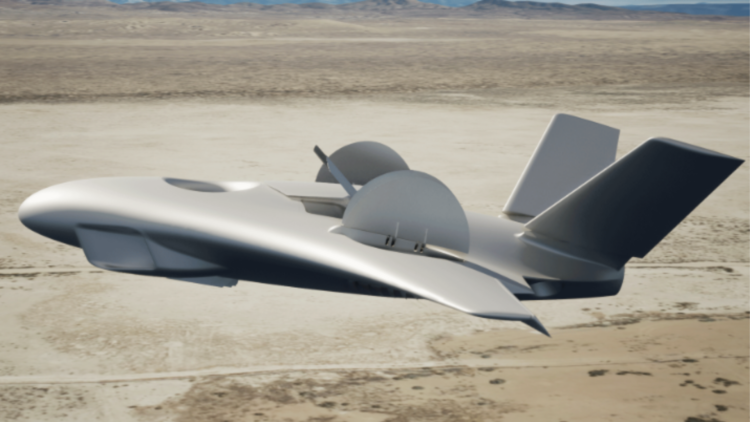The battlefield of tomorrow demands a new breed of aircraft—one that transcends the limitations of traditional jets and helicopters, offering unparalleled speed, agility, and the ability to operate from anywhere. Enter the Defense Advanced Research Projects Agency (DARPA)’s Speed and Runway Independent Technologies (SPRINT) program, a revolutionary initiative poised to redefine military air mobility.
At the forefront of this program stands Aurora Flight Sciences, a Boeing subsidiary, with its ingenious fan-in-wing (FIW) design—a technological marvel that promises to rewrite the rulebook for military aviation.
Breaking the Speed Barrier
Forget the sluggish speeds of conventional VTOLs (vertical takeoff and landing).
The SPRINT program envisions an X-plane, a high-tech demonstrator, that shatters these limitations.
DARPA’s target is a blistering 450 knots (roughly 518 mph) cruise speed. This is where Aurora’s FIW shines.
Its low-drag, blended wing body platform – essentially a wider, more aerodynamic fuselage that seamlessly integrates with the wings – creates a sleek, efficient design that slices through the air with minimal resistance. This translates to game-changing speed for military operations.
Imagine rapid troop deployment behind enemy lines, swift medical evacuation from remote locations, or high-speed resupply missions for forward operating bases – all conducted in a fraction of the time it takes with current aircraft.
Vertical Agility for Unmatched Access
Speed is just one piece of the puzzle. The true power of the FIW lies in its ability to take off and land vertically.
Embedded within the wings are three powerful lift fans, which allow the X-plane to operate from unprepared surfaces—think dusty clearings, rooftops, or even inside damaged buildings.
This vertical agility is a boon for Special Operations Forces (SOF), which often operate in austere environments without runways.
Rapid infiltration and exfiltration of troops have become a reality, giving SOF unprecedented tactical freedom and flexibility.
Already have an account? Sign In
Two ways to continue to read this article.
Subscribe
$1.99
every 4 weeks
- Unlimited access to all articles
- Support independent journalism
- Ad-free reading experience
Subscribe Now
Recurring Monthly. Cancel Anytime.
Imagine a scenario where a team needs to insert behind enemy lines to conduct a critical operation. With the FIW X-plane, they can land discreetly in a hidden location, conduct their mission, and then extract just as swiftly, minimizing exposure and maximizing the element of surprise.
Artist’s rendering of a vertical lift X-plane concept. (Image source: Aurora Flight Sciences)
A Design Built for the Future
The FIW isn’t just a one-trick pony. Its modular design allows for scalability.
The initial design utilizes three lift fans, but Aurora envisions incorporating more in the future, catering to heavier payloads or longer ranges.
This adaptability ensures the X-plane’s relevance as military needs evolve.
Additionally, the FIW technology isn’t limited to unmanned drones.
Aurora emphasizes that the core principles can be transitioned to crewed aircraft, further expanding the operational spectrum.
Imagine a future where high-speed VTOL transports ferry troops and equipment across vast distances, or agile, armed FIW fighters provide close air support with unmatched speed and maneuverability.
Efficiency is Key for the X-plane
Military operations thrive on efficiency.
The FIW concept prioritizes existing engine solutions, streamlining development and minimizing risk.
By leveraging proven technologies, Aurora ensures a faster path to a functional prototype. This not only reduces development costs but also expedites the X-plane’s transition from drawing board to operational reality.
Time saved is lives saved, and in the fast-paced environment of modern warfare, every second counts.
Multifaceted Takeoff and Landing Options
While vertical agility is paramount, the FIW doesn’t limit itself to VTOL operations.
This X-plane boasts additional capabilities, including short takeoff and vertical landing (STOVL) and super short takeoff and landing (SSTOL).
Imagine a scenario where a damaged runway is partially accessible. With STOVL capabilities, the FIW can land safely using the remaining runway length, delivering critical supplies even in compromised situations.
Similarly, SSTOL allows takeoffs from surprisingly short distances, providing tactical advantages in situations where long runways aren’t available.
The SPRINT program, spearheaded by Aurora’s innovative FIW design, signifies a monumental leap forward in military air mobility. This collaboration between Aurora and Boeing brings together over 30 years of expertise in VTOL platforms.
As reported by the company last week, May 20, their preliminary design review is expected in a year, and the first flight is projected for 2027.
While the initial X-plane won’t be a mass-produced weapon, it serves as a crucial test bed for these transformative technologies.
The data gleaned from flight tests will pave the way for the next generation of military aircraft, fundamentally altering how forces operate and missions are conducted.
The future of warfare is taking flight, and it’s moving fast.

